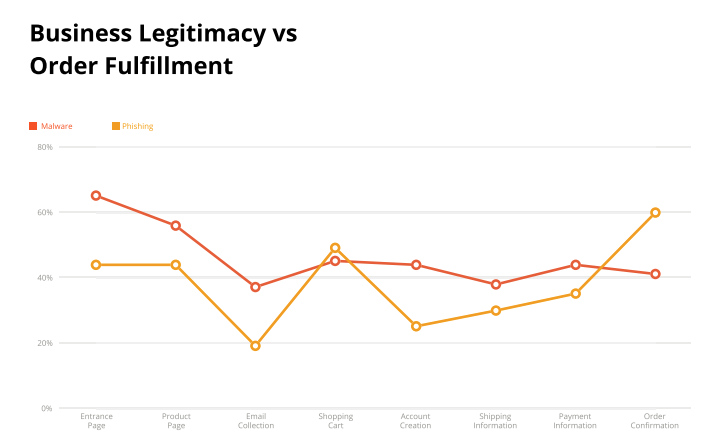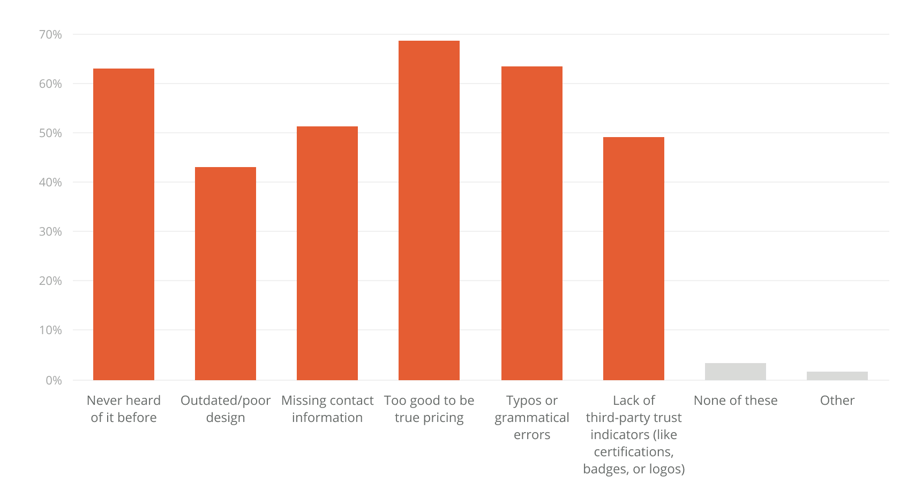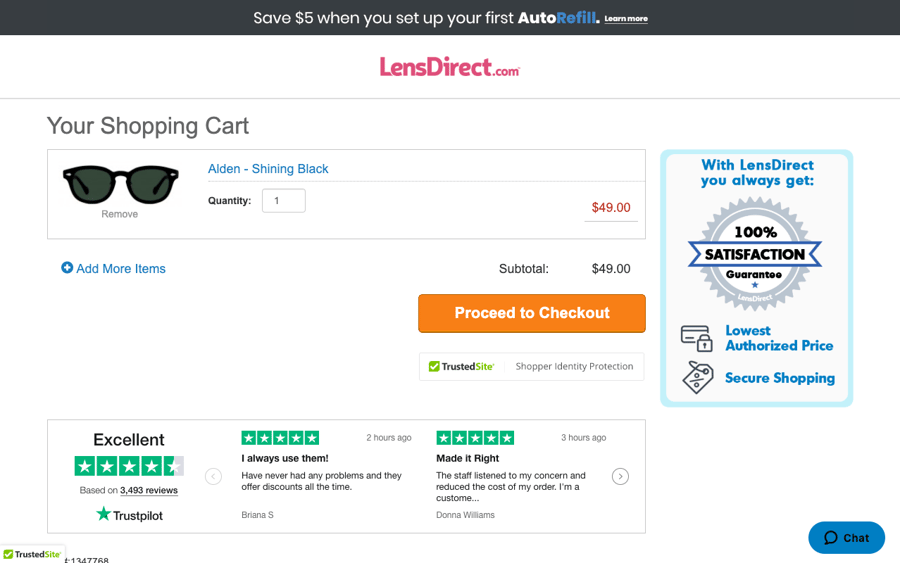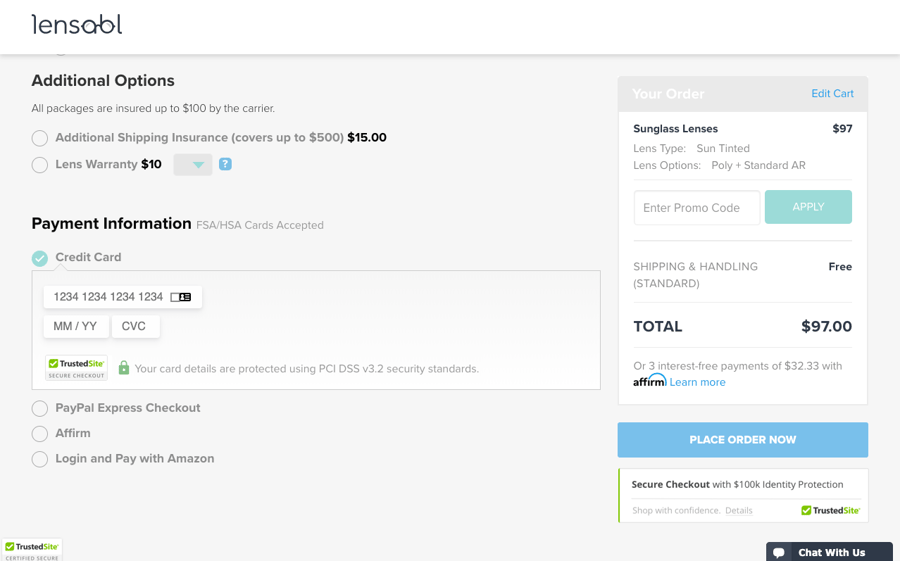
Consumers understand that there are inherent risks when shopping online, and are particularly concerned about shopping at unfamiliar websites.
In hopes of preventing disasters like identity theft, stolen credit card information, and hacked devices, many consumers take care to thoroughly research the sites they shop at, and many find reasons not to complete a purchase. So many, in fact, that the average ecommerce shopping cart abandonment rate is as high as 69.57% according to the Baymard Institute.
TrustedSite recently surveyed 600 US-based consumers through Survey Monkey Audiences and found that over 92% of consumers are concerned about websites they have not shopped at in the past, up 2% since the survey was last conducted in 2018.
According to TrustedSite’s research, the concerns that can cause shoppers to abandon a site shift throughout each stage of the buyer’s journey. In other words, the things that shoppers are most worried about when they first arrive at a site can differ from the things they are most worried about when viewing their cart or checking out.
For instance, business legitimacy and order fulfillment are two concerns that can arise when visitors are evaluating a new site. Take a look at how these concerns shift throughout the buyer’s journey in the following graph.

Consumer concerns like business legitimacy and order fulfillment can be troublesome in multiple areas, but are held most prominently on opposite ends of the buyer’s journey according to TrustedSite’s 2020 Survey Monkey Audiences survey of 600 US based consumers.
When first arriving at an unfamiliar site, visitors aren’t sure if there is a real business behind the site, but by the end of the checkout process they are more concerned about receiving their order.
To convert more visitors into buyers, ecommerce sites need to build trust by addressing the concerns that can derail a purchase at each stage of the buyer’s journey. Follow our recommendations below to increase the confidence of your visitors and boost your sales.
Show you’re trustworthy on every page
When a consumer lands on a new site for the first time, they have little to no preexisting knowledge about the people running it, how long they’ve been in business, and whether they fulfill their promises. If the shopper can’t easily find this information within seconds, they may just decide to take their business elsewhere.
In fact, ecommerce sites have an average bounce rate of 45.68%, meaning close to half of shoppers don’t get past the first page they land on.
If you’re managing an ecommerce site, your goal is to not only attract visitors to your site, but to move them through each stage of the buyer’s journey until they complete a purchase. If nearly half of your visitors flee after seeing only one page, then your pipeline of potential customers is significantly depleted.
When asked what they are concerned about when first arriving at an unfamiliar site, 65% of surveyed consumers said they worry about whether the business is legitimate. This comes as no surprise considering that every year individuals and businesses lose billions of dollars at the hands of internet scammers.
To build trust among new visitors, ecommerce sites need to make sure that visitors immediately see signs of business legitimacy when they arrive at the site. And since visitors can, in theory, enter a site through any of its pages, every page needs to include clear indications of trust.
To help sites find ways to achieve this, TrustedSite asked consumers what things they consider to be signs of a fraudulent business.

What causes you to be concerned that a website might be a fraudulent business? Survey Monkey Audiences, 2020.
Aside from never hearing of a site before, too-good-to-be-true pricing and typos were among the top signals of fraud. Ensure you’re using a competitive pricing model and frequently scanning your site for copy errors to prevent visitors from mistaking your site as fake. There are tons of free website spell checkers out there, so there’s no reason not to use one!
Missing contact information was another significant sign of fraud to 50% of consumers. Make it easy for visitors to find your contact information and get in touch by including your business phone number, email address, and physical address in key areas such as your site’s header and footer and your about page. If you have the resources to operate a live chat, that’s another way you can reassure visitors that there are real people behind your site.
Additionally, many consumers said a lack of third-party trust indicators like badges or logos can be a sign of a fake site. When a third-party vouches for you, your site gains more credibility beyond the claims you make yourself. Show visitors that your site is regularly monitored for issues by placing trust badges from a reputable source across your site.
Be clear about how you handle customer information
Consumers are hesitant to share their personal information online, especially on sites they aren’t familiar with. When offered a discount in exchange for their email address, 57% of surveyed consumers said they worry about receiving spam. And when asked to create an account with their name and email, 55% of consumers said they are concerned about this information being stolen.
This isn’t great news for ecommerce sites. Visitors are not going to sign up for your email list, let alone make a purchase if they feel their personal information is at risk on your site. Nearly a quarter of consumers said they have abandoned a purchase because they were worried about receiving email spam, and over 30% have abandoned a purchase over concerns about the security of their contact information.
To combat these concerns, you should accompany any form asking for personal information with copy that clearly explains what you’ll do with it.
Asking for an email sign up? If you’re using SSL, tell visitors that their email address will be safely transmitted through your form. Additionally, let them know what kinds of communications they can expect to receive. Take it one step further by including a checklist that lets the visitor decide which types of information they want sent to them (e.g. discounts, promotions, product releases, etc.)
You’ll also want to communicate how you handle personal information at checkout, especially when it comes time for the customer to input payment information. Include copy in the payment information section that explains the measures you take to securely transmit and process this data. Finally, ask customers for permission to store their credit card information on file for future purchases. Giving your customers control over their own information can help to increase their trust in your site.
Include social proof on pages where order fulfillment concerns are highest
If a customer is concerned that a site won’t fulfill their order to their expectations, they won’t complete a purchase. TrustedSite found that concern about order fulfillment is strongest in two stages of the buyer’s journey. The shopping cart is where 49% of surveyed consumers reported having this concern, while 60% of consumers were also concerned about this when viewing the order confirmation page.
Social proof can help to alleviate concerns about order fulfillment. If potential customers can see the praises given by your previous customers, it shows that you will likely satisfy their expectations as well.
There are tons of different ways to include social proof on your site. One of the most common is to use a reviews service such as Trustpilot or ResellerRatings, which sometimes can also help to improve SEO by displaying your reviews alongside your site in search engine results. We recommend including reviews on your shopping cart and order confirmation pages as these are the areas where concerns about order fulfillment are highest, but reviews can also work great on your homepage and product pages.

LensDirect includes customer reviews through Trustpilot on their shopping cart page.
Another way that ecommerce sites can display social proof is to embed a feed of posts from your social media accounts. Whenever a customer tags or mentions you in a post, repost it to your account so that it will appear in the feed on your site. Make sure you obtain permission to repost any content that’s not your own and give credit to the original poster!
Give credit card fields visual indications of security
Nearly 75% of consumers report being concerned about the security of their credit card information when checking out on an unfamiliar site. This concern is held so widely given that if a customer’s credit card information were stolen, their finances could be immediately impacted.
Baymard Institute has been conducting ecommerce checkout research for years and has made some interesting discoveries about how shoppers decide to trust a site enough to make a purchase. They’ve learned that visitors’ perception of security is often determined by their gut feeling, and that visual design can cause them to perceive some parts of a page as more secure than other sections on the same page.
Though you should absolutely ensure your checkout (and your site as a whole) is secure from a technical standpoint, it’s just as important to make sure there is a visual representation of security.

Lensabl’s checkout includes a border around the credit card information section, copy informing customers that their card details are protected by industry-standard security measures, and a trust badge near the credit card fields.
Baymard recommends giving credit card fields a distinct visual design with borders, background colors, and shading that makes the fields stand out from the main styling of the page. They also recommend including trust badges, SSL seals, or similar symbols to suggest trustworthiness.
Generally, they found that any type of badge can help to increase trust, but those from well-known brands tend to do so the most. Including these badges as close as possible to the credit card fields ensures that customers will notice them at the opportune moment.
Ensure mobile visitors know you’re trustworthy, too
M-commerce, or mobile commerce, is on the rise with mobile sales projected to reach up to 45% of the ecommerce market this year.
With this, concerns about shopping on mobile have also increased. In 2020, over 84% of consumers said they are concerned about providing personal information when shopping online on a smartphone, up from 66% in 2018.
With so many of your potential customers shopping on their smartphones, it’s important to make sure your trust-building efforts are visible to them as well. This may require some changes such as finding a new location to display your contact information and strategically placing trust badges so that one is always visible to visitors as they scroll through your pages.
The Shoe Mart tested a mobile-optimized trust badge against a competing badge that was not fully mobile optimized. The mobile-optimized badge helped increase mobile conversions by 21%.
Online footwear retailer The Shoe Mart recently achieved a 21% increase in mobile conversions when they tested TrustedSite, a mobile compatible trust-building service. They ran an experiment that tested TrustedSite against Norton Shopping Guarantee and believe mobile conversions increased because some of the Norton badges were not visible to shoppers on their smartphones.
Looking forward
Building trust among your visitors is not as difficult as it may seem. Many of our suggestions are quick and easy updates that you can implement today! Start with some of the simpler things like adding more copy to your forms, and then make a plan to incorporate things that may take more effort like implementing a reviews service and embedding social media feeds. With more trust indicators throughout your site, you can hope to see great improvements in your conversions and revenue!





Leave a reply or comment below